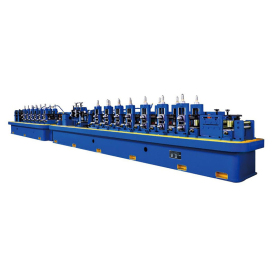[Tube making machine with cutting function]Revolutionizing Manufacturing: The Benefits and Features of Tube Making Machines with Cutting Function
News 2024-8-7
In the rapidly evolving world of manufacturing, efficiency and precision are paramount. Among the various machines that have transformed production processes, the tube making machine with cutting function stands out for its versatility and capability. This advanced machinery has redefined how manufacturers produce tubes for diverse applications, ranging from construction to automotive and beyond. In this article, we will explore the features, benefits, and applications of tube making machines equipped with cutting functions, shedding light on why they are becoming indispensable in modern industry.

Revolutionizing Manufacturing: The Benefits and Features of Tube Making Machines with Cutting Function
Tube making machines are specialized tools designed for the production of tubes and pipes, typically from raw materials such as steel, aluminum, and plastic. These machines can accommodate various specifications in terms of diameter, wall thickness, and length, allowing manufacturers to create products tailored to specific needs. With the integration of cutting functions, these machines have become even more efficient, enabling users to produce finished tubes ready for immediate use.
**Key Features of Tube Making Machines with Cutting Function**

Revolutionizing Manufacturing: The Benefits and Features of Tube Making Machines with Cutting Function
2. **High-Speed Production**: With advanced technology, tube making machines boast high-speed production capabilities. The cutting function operates seamlessly with the tube formation process, resulting in a continuous workflow that significantly reduces production times.

Revolutionizing Manufacturing: The Benefits and Features of Tube Making Machines with Cutting Function
4. **Versatility**: Tube making machines with cutting functions can handle a wide range of materials and sizes, making them suitable for various industries, including construction, HVAC, automotive, and plumbing, among others. This versatility makes them a valuable asset for manufacturers looking to diversify their product offerings.
5. **Quality Assurance**: Modern tube making machines incorporate quality control systems that monitor the production process for any deviations from set specifications. The integrated cutting function ensures that only tubes that meet quality standards proceed to the next phase of production.
**Benefits of Using Tube Making Machines with Cutting Function**
1. **Efficiency and Cost-Effectiveness**: By integrating the cutting function within the tube making process, manufacturers can save time and reduce labor costs associated with manual cutting. This efficiency translates into cost savings, allowing companies to remain competitive in the marketplace.
2. **Reduced Waste**: The precision of the integrated cutting function minimizes scrap material. Manufacturers can produce tubes with exact dimensions, which not only conserves resources but also reduces disposal costs for waste materials.
3. **Enhanced Product Quality**: Tube making machines with cutting functions are designed to maintain high tolerances, ensuring consistent product quality. This reliability in production enhances customer satisfaction and fosters repeat business.
4. **Streamlined Production Processes**: The automation and integration of functions make for a smoother production process. This streamlining allows manufacturers to focus on other critical areas of production while the machine handles the tube making and cutting tasks.
**Applications of Tube Making Machines with Cutting Function**
The applications for tube making machines with cutting capabilities span a broad spectrum of industries. In construction, they are used to create structural steel tubes and pipes. The automotive industry utilizes them for producing exhaust pipes and chassis components. HVAC systems require tubes for ductwork, while plumbing systems depend on reliable and durable pipes. Additionally, the energy sector employs these machines in the production of piping for oil and gas applications.
**Conclusion**
As industries continue to evolve, the demand for efficient and precise manufacturing solutions remains high. Tube making machines with cutting functions embody this trend, offering manufacturers the tools they need to produce high-quality tubes swiftly and economically. Their integrated systems, automated controls, and versatility make them an essential investment for companies aiming to enhance their production capabilities. As technology continues to advance, we can expect to see further innovations in tube making machines that will further revolutionize the manufacturing landscape.
